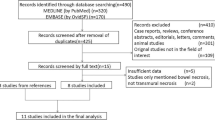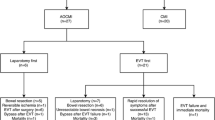Abstract
Objectives
To evaluate the diagnostic performance of CT for transmural necrosis (TN) in non-occlusive mesenteric ischemia (NOMI) according to the bowel segment involved.
Methods
From January 2009 to December 2019, all patients admitted to the intensive care unit (ICU) and requiring laparotomy for NOMI were retrospectively studied. CT had to have been performed within 24 h prior to laparotomy and were reviewed by two abdominal radiologists, with a consensus reading in case of disagreement. A set of CT features of mesenteric ischemia were assessed, separating the stomach, jejunum, ileum, and right (RC) and left colon (LC). Univariate and multivariate analyses were performed to identify features associated with TN. Its influence on overall survival (OS) was assessed.
Results
Among 145 patients, 95 (66%) had ≥ 1 bowel segment with TN, including 7 (5%), 31 (21%), 43 (29%), 45 (31%), and 52 (35%) in the stomach, jejunum, ileum, RC, and LC, respectively. Overall inter-reader agreement of CT features was significantly lower in the colon than in the small bowel (0.59 [0.52–0.65] vs 0.74 [0.70–0.77] respectively). The absence of bowel wall enhancement was the only CT feature associated with TN by multivariate analysis, whatever the bowel segment involved. Proximal TN was associated with poorer OS (p < 0.001).
Conclusions
The absence of bowel wall enhancement remains the most consistent CT feature of transmural necrosis, whatever the bowel segment involved in NOMI. Inter-reader agreement of CT features is lower in the colon than in the small bowel. Proximal TN seems to be associated with poorer OS.
Key Points
• The absence of bowel wall enhancement is the most consistent CT feature associated with transmural necrosis in NOMI, whatever is the bowel segment involved.
• Inter-reader agreement is lower in the colon than in the small bowel in NOMI.
• In NOMI, the more proximal the bowel necrosis, the worse the prognosis.






Similar content being viewed by others
Change history
12 March 2021
A Correction to this paper has been published: https://doi.org/10.1007/s00330-021-07829-6
Abbreviations
- AMI:
-
Acute mesenteric infarction
- ASAT:
-
Aspartate aminotransferase
- AUC:
-
Area under the curve
- CT:
-
Computed tomography
- ICU:
-
Intensive care unit
- LC:
-
Left colon
- NAD:
-
Noradrenaline
- NOMI:
-
Non-occlusive mesenteric ischemia
- NPV:
-
negative predictive value
- OMI:
-
Occlusive mesenteric ischemia
- OS:
-
Overall survival
- PPV:
-
positive predictive value
- RC:
-
Right colon
References
Schoots IG, Koffeman GI, Legemate DA, Levi M, van Gulik TM (2004) Systematic review of survival after acute mesenteric ischaemia according to disease aetiology. Br J Surg 91:17–27. https://doi.org/10.1002/bjs.4459
Trompeter M, Brazda T, Remy CT, Vestring T, Reimer P (2002) Non-occlusive mesenteric ischemia: etiology, diagnosis, and interventional therapy. Eur Radiol 12:1179–1187. https://doi.org/10.1007/s00330-001-1220-2
Pérez-García C, de Miguel CE, Fernández Gonzalo A et al (2018) Non-occlusive mesenteric ischaemia: CT findings, clinical outcomes and assessment of the diameter of the superior mesenteric artery. Br J Radiol 91:20170492. https://doi.org/10.1259/bjr.20170492
Gnanapandithan K, Feuerstadt P (2020) Review article: mesenteric ischemia. Curr Gastroenterol Rep 22:17. https://doi.org/10.1007/s11894-020-0754-x
Nuzzo A, Maggiori L, Ronot M et al (2017) Predictive factors of intestinal necrosis in acute mesenteric ischemia: prospective study from an intestinal stroke center. Am J Gastroenterol 112:597–605. https://doi.org/10.1038/ajg.2017.38
Kammerer S, Schuelke C, Berkemeyer S et al (2018) The role of multislice computed tomography (MSCT) angiography in the diagnosis and therapy of non-occlusive mesenteric ischemia (NOMI): Could MSCT replace DSA in diagnosis? PLoS One 13:e0193698. https://doi.org/10.1371/journal.pone.0193698
Menke J (2010) Diagnostic accuracy of multidetector CT in acute mesenteric ischemia: systematic review and meta-analysis. Radiology 256:93–101. https://doi.org/10.1148/radiol.10091938
Atre ID, Eurboonyanun K, O’Shea A et al (2020) Predictors of transmural intestinal necrosis in patients presenting with acute mesenteric ischemia on computed tomography. Abdom Radiol (NY). https://doi.org/10.1007/s00261-020-02558-8
Emile SH (2018) Predictive factors for intestinal transmural necrosis in patients with acute mesenteric ischemia. World J Surg 42:2364–2372. https://doi.org/10.1007/s00268-018-4503-3
Emile SH, Khan SM, Barsoum SH (2020) Predictors of bowel necrosis in patients with acute mesenteric ischemia: systematic review and meta-analysis. Updates Surg. https://doi.org/10.1007/s13304-020-00857-9
Calame P, Malakhia A, Turco C, Grillet F, Piton G, Delabrousse E (2019) Transmural bowel necrosis from acute mesenteric ischemia and strangulated small-bowel obstruction: distinctive CT features. AJR Am J Roentgenol 214:90–95. https://doi.org/10.2214/AJR.19.21693
Rondenet C, Millet I, Corno L, Boulay-Coletta I, Taourel P, Zins M (2018) Increased unenhanced bowel-wall attenuation: a specific sign of bowel necrosis in closed-loop small-bowel obstruction. Eur Radiol 28:4225–4233. https://doi.org/10.1007/s00330-018-5402-6
Kanasaki S, Furukawa A, Fumoto K et al (2018) Acute mesenteric ischemia: multidetector CT findings and endovascular management. Radiographics 38:945–961. https://doi.org/10.1148/rg.2018170163
Millet I, Taourel P, Ruyer A, Molinari N (2015) Value of CT findings to predict surgical ischemia in small bowel obstruction: a systematic review and meta-analysis. Eur Radiol 25:1823–1835. https://doi.org/10.1007/s00330-014-3440-2
Copin P, Zins M, Nuzzo A et al (2018) Acute mesenteric ischemia: a critical role for the radiologist. Diagn Interv Imaging 99:123–134. https://doi.org/10.1016/j.diii.2018.01.004
Garzelli L, Nuzzo A, Copin P et al (2020) Contrast-enhanced CT for the diagnosis of acute mesenteric ischemia. AJR Am J Roentgenol 1–10. https://doi.org/10.2214/AJR.19.22625
Madl C, Druml W (2003) Gastrointestinal disorders of the critically ill. Systemic consequences of ileus. Best Pract Res Clin Gastroenterol 17:445–456. https://doi.org/10.1016/s1521-6918(03)00022-2
Atre ID, Eurboonyanun K, O’Shea A et al (2020) Predictors of transmural intestinal necrosis in patients presenting with acute mesenteric ischemia on computed tomography. Abdom Radiol (NY). https://doi.org/10.1007/s00261-020-02558-8
Barrett T, Upponi S, Benaglia T, Tasker AD (2013) Multidetector CT findings in patients with mesenteric ischaemia following cardiopulmonary bypass surgery. Br J Radiol 86. https://doi.org/10.1259/bjr.20130277
Canfora A, Ferronetti A, Marte G et al (2019) Predictive Factors of Intestinal Necrosis in Acute Mesenteric Ischemia. Open Med (Wars) 14:883–889. https://doi.org/10.1515/med-2019-0104
Bourcier S, Oudjit A, Goudard G et al (2016) Diagnosis of non-occlusive acute mesenteric ischemia in the intensive care unit. Ann Intensive Care 6:112. https://doi.org/10.1186/s13613-016-0213-x
Wong Y-C, Wu C-H, Wang L-J, Chen H-W, Lin B-C, Huang C-C (2013) Mesenteric vascular occlusion: comparison of ancillary CT findings between arterial and venous occlusions and independent CT findings suggesting life-threatening events. Korean J Radiol 14:38–44. https://doi.org/10.3348/kjr.2013.14.1.38
Copin P, Ronot M, Nuzzo A et al (2018) Inter-reader agreement of CT features of acute mesenteric ischemia. Eur J Radiol 105:87–95. https://doi.org/10.1016/j.ejrad.2018.05.027
Chuong AM, Corno L, Beaussier H et al (2016) Assessment of bowel wall enhancement for the diagnosis of intestinal ischemia in patients with small bowel obstruction: value of adding unenhanced CT to contrast-enhanced CT. Radiology 280:98–107. https://doi.org/10.1148/radiol.2016151029
Mazzei MA, Volterrani L (2015) Nonocclusive mesenteric ischaemia: think about it. Radiol Med 120:85–95. https://doi.org/10.1007/s11547-014-0460-6
Horton KM, Fishman EK (2001) Multi–detector row CT of mesenteric ischemia: can it be done? Radiographics 21:1463–1473. https://doi.org/10.1148/radiographics.21.6.g01nv091463
Guillaume A, Pili-Floury S, Chocron S et al (2017) Acute mesenteric ischemia among postcardiac surgery patients presenting with multiple organ failure. Shock 47:296–302. https://doi.org/10.1097/SHK.0000000000000720
Funding
The authors state that this work has not received any funding.
Author information
Authors and Affiliations
Corresponding author
Ethics declarations
Guarantor
The scientific guarantor of this publication is Eric Delabrousse.
Conflict of interest
The authors of this manuscript declare no relationships with any companies whose products or services may be related to the subject matter of the article.
Statistics and biometry
One of the authors has significant statistical expertise (Paul Calame).
Informed consent
Written informed consent was waived by the Institutional Review Board.
Ethical approval
Institutional Review Board approval was obtained.
Methodology
• retrospective
• observational
• performed at one institution
Additional information
Publisher’s note
Springer Nature remains neutral with regard to jurisdictional claims in published maps and institutional affiliations.
The original online version of this article was revised: Paul Calame is affiliated with two institutions.
Rights and permissions
About this article
Cite this article
Verdot, P., Calame, P., Winiszewski, H. et al. Diagnostic performance of CT for the detection of transmural bowel necrosis in non-occlusive mesenteric ischemia. Eur Radiol 31, 6835–6845 (2021). https://doi.org/10.1007/s00330-021-07728-w
Received:
Revised:
Accepted:
Published:
Issue Date:
DOI: https://doi.org/10.1007/s00330-021-07728-w




